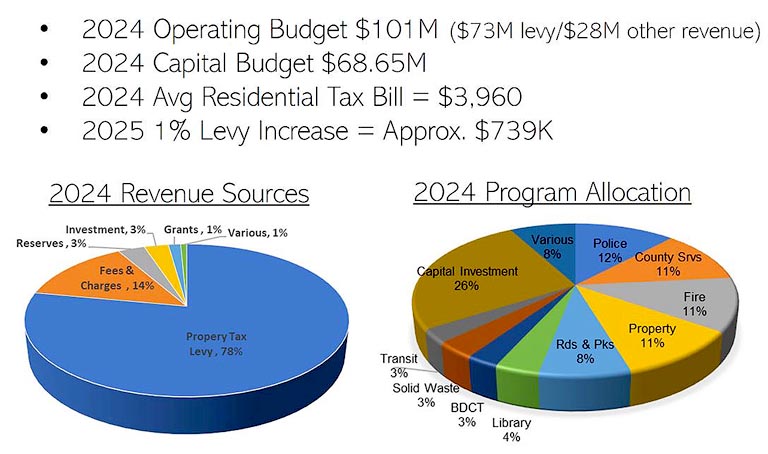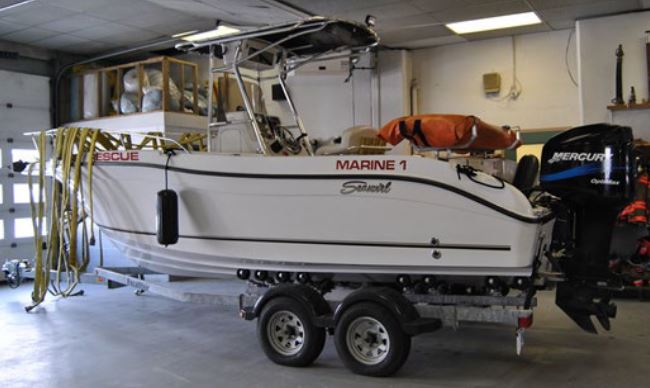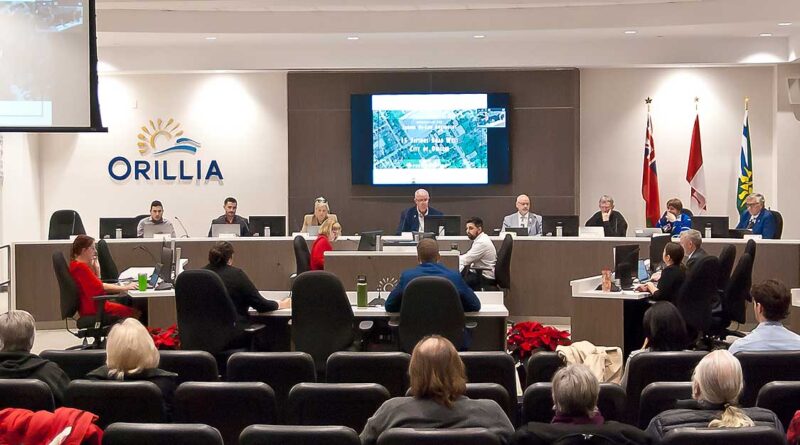Council Preview
By John Swartz
Orillia council’s last meeting before the summer schedule starts is at noon Monday June 17 with a budget committee meeting. This happens annually in June so staff can get council’s direction on some key items that in many cases have effect on budgets for years to come.
The first item is about the overall direction and the ten-year capital plan. The 2024 operating budget was $101 million all together. This included $73 million from the tax levy and $28 million from other sources. The capital budget was $69 million.

Contained in the report is a line that has been used repeatedly over the last 30 years, that the budget will, “face uncertainty and pressures given the current economic climate.”
Staff estimate, based on current department requests and plans for new service based on past council decisions, the increase for 2025 will be in the range of 2.89 to 6.88%. Council usually sets a target number at these June meetings. Each percentage point translates to approximately $700k of new tax revenue
Contributing to the increase are things like general inflation of 1.8 to 3.4% just to do the things the City already does. Staff also are factoring a 2.5% increase in costs for capital projects.
The City also spends money on contracts for service. Policing, ambulance and other services from the County of Simcoe, and the Simcoe Muskoka District Health Unit fit here. In 2024 those accounted for $20 million of the City’s budget. Staff is predicting those costs will go up 2%.
Staff expect the assessment will grow by $1 million based on past performance. This amount is calculated by the provincial Municipal Property Assessment Corporation, which typically does not let municipalities know the amounts until December (and of course Orillia does its budget at the end of November). Staff note that in recent years the actual growth of assessment has been short of staff predictions. MPAC is the same group that puts valuations on your house and changes have been frozen since 2020, the year they were due to be adjusted, so in reality the numbers are based on 2016 figures.
The Ontario government, through Bill 23 shifted some of the cost of development from developers to your municipal taxes. Council set up a $1 million reserve to dip into to cover shortfalls, which staff estimate to be $12 million. Staff are not recommending getting rid of that reserve. The province’s new Cutting Red Tape to Build More Homes bill will change things, staff believe favourably, but it’s too early to tell since the bill was only passed June 6.
Staff say there are already 10 items referred to the 2025 budget committee, which involve an increased budget from these areas council has decided are their priorities:
- Affordable Housing
- Homelessness and Warming Centers
- Customer Service
- Boundary Review
- Traffic Calming & Road Maintenance
- Infrastructure Repair and Renewal Funding
Expect your water bill to go up in 2025. Staff are projecting a low increase of 6.2% on water to a high of 28.6% for storm water. Most of the money collected goes into annual operation of those systems, with any surpluses going to reserves. Except for storm water, council decided a few years ago to create a reserve for storm water system upgrades in advance of the province telling municipalities they will have to treat storm water as they do with waste water. Most of the money collected so far is in reserve, but the City has done some work on the system to filter out large items that get caught in the storm water flows.
It’s important to note that much of the road work being done in town also involves replacing water and waste water pipes. You can’t replace those without redoing the roads above, so a good part of the cost of projects like the Laclie Street Reconstruction is paid for from water reserves.
Regarding the 10-year capital plan, staff are projecting the City will need $789 million to fund all the projects currently on the list, which is $315 million more than last year. But, the list is still in development. When the list was first created several years ago the projected amount needed was $842 million.
Only 4% of the tax levy goes to capital projects, based on practice, with most of the funding coming from various reserves (current balance $114 million) and other sources like grants from higher levels of government. Of course the some of reserves funding comes annually from the budget, so it’s like banking money for future use.
Staff say the total amount of reserves will be used up by 2031, if contributions, or costs of projects on the list don’t change. Bottom line, expect your tax bill to go up to put money into reserves, if not this year, soon.
New Budget Items

There are a few. One is a report, which will likely get forwarded to the 2025 Budget deliberations, to replace one of the fire department’s boats. The main boat has an old Mercury Optimax 225 hp outboard motor for which replacement parts have been unavailable for several years. If there is a failure the replacement for the motor is estimated to be $80,000. During a 2022 inspection wood rot was found in the gunwhale frame.
Staff recommend council add replacement at a cost of $297,852 to the ten-year capital plan.
Next is a report outlining the criteria for road and sidewalk reconstruction and resurfacing. It’s an information report and will not change budgets. Staff outline projects expected in the next three years.
For reconstruction Jarvis from Bay to West Streets is a two year project, Wyandotte Street from Colborne to Mississaga and the balance of the Laclie Street project are planned.
The resurfacing list has 9 projects for 2025 (West, Westmount and North Streets) valued at $2 million; 8 projects for 2026 (Canice, Penetang, Dale and other streets) valued at $1 million; 7 projects in 2027 (Cameron, McKinnell, Shannon and other streets) valued at $1 million.
Missing from either list is Commerce Drive which is falling apart, with new chunks missing daily.
Sidewalks listed for replacement during the next three years include Albert, Bay, Mary, McKenzie, Neywash, Gill and other streets for a total of $2 million.
The next report is letting council know a maintenance assessment needs to be done on all the City’s storm water ponds. While those in charge at the province pay little heed to the effects of climate change, those who actually run things have indicated they expect precipitation to increase in the next 30 years. Doing a study and maintenance work is necessary to prevent flooding. The report is background for why this is included in the ten-year capital forecast. As it is staff included $300K in the 2025 budget to get maintenance rolling on an eight-year project which will cost $4.2 million.
The last two reports outline reasons for new figures relating to the City’s fleet and to facilities ten-year capital plans. Both have increased. The fleet funding projection went from $12 million to $26 million, while the facility requirement went from $51 million to $92 million. As the development of an asset management system has evolved more accurate inspection and costing revealed earlier estimates were low. The fleet requirements are mostly for replacements, while facilities are maintenance issue mostly.
On To The Regular Meeting
Council meetings cannot start until 2 p.m., so there will either be a long break, or they’ll start late. First up are two deputations.
Deborah Watson, chair, and Meagan Wilkinson, acting CEO, of the Orillia Public Library will present the library’s 2023 annual report. Next Mark Watson, Dylan Court, and Mike Best of Orillia Skate Parkers will ask council to revisit the building plans for the Skatepark proposed for Foundry Park. They want to impress on council the support the project has received from people in Orillia and surrounding area.
Once those are done and the public forum is over, council will go into closed session for two items. One is a report on land the City is interested in for use by the Youth Centre and Seniors Centre. The other is an outline of the recruitment plan to replace the retiring general manager of development services, Ian Sugden.
When council come back to the public meeting, they have three reports on the agenda. The first is from staff to delegate authority to the general manager of environment and infrastructure services to approve parade permits, and to add a $100 permit fee.
Previously the Orillia police services board issued permits and with the change in how police service boards are constituted, the current by-law became obsolete.
Next is what will surely be a lengthy presentation on the result of consultations to update the Downtown Tomorrow Plan. There are 7 goals and 31 initiatives in the updated draft plan. If council accepts the report there will be another round of public consultation, including an online survey staring later in June, with a goal to have a final draft ready in the fall.
The one thing material to the presentation is a staff recommendation to change the funding of $120K, half of which was to come from the capital levy reserve and half from the economic recovery funds, to the entire amount from the capital levy reserve.
This one will be worth watching online at the link below (or in person).
All municipalities have to have an asset management plan in place by July 1. To that end the next item on the agenda is staff’s recommended plan. Such plans take stock of the current condition of assets and the recommended maintenance and replacement over the useful life of those assets.
If the City had to replace everything right now, they would need $2 billion dollars. The most likely candidates for near-term replacement are the fleet and information technology hardware and software. All the water systems and treatment facilities have the longest life span with less than half of the facilities being at the halfway mark of usefulness.
The plan effects the ten-year capital funding plan with only $1 million short of identified funding sources for the $39 million needed. The management plan will guide council and staff what to prioritize and prepare for maintaining current levels of service.
Motions
Councillors Tim Lauer and Janet-Lynne Durnford have one to install temporary 4-way stops on Lightfoot Drive at Neywash and Canice and Brant Streets until the end of the construction season. The cost of $5,000 will come from the operating contingency budget.
Councillors jay Fallis and Jeff Czetwerzuk have an enquiry motion to have staff report to the 2025 budget committee to install three solar powered speed signs, two on Stone Ridge Blvd. and one on Bass Lake Sideroad. The same councillors have another for staff to report on the feasibility of creating a community safety zone on Atlantis Drive between Clayt French Park and Highway 12.
Councillor Lauer has an enquiry motion to have staff report on tree management issues in the Downtown Business Improvement Area.
Council meetings are open to the public or can be watched on the City’s Youtube channel – budget here and regular meeting here.
(Photos by Swartz – SUNonline/Orillia)




